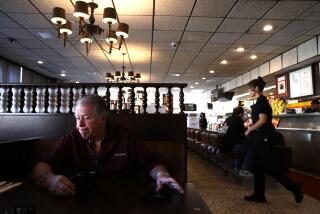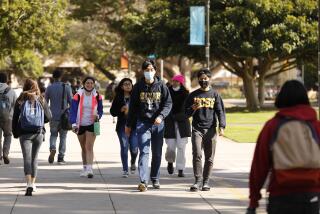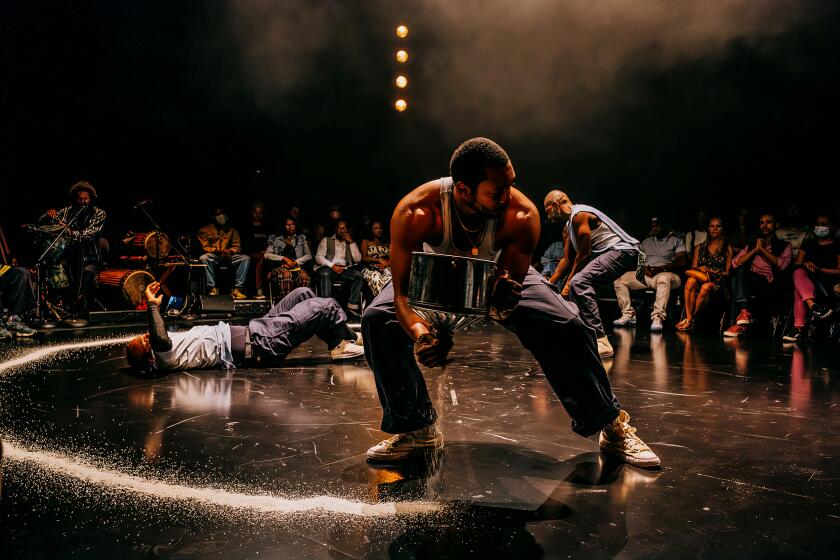Day of the Dead Observances Move North
The holiday is the Mexican Dia de los Muertos--Day of the Dead--but the observance has a definite L.A. accent.
In Studio City, a group of women attending a cultural workshop learns how to decorate the traditional sugar skulls that evoke the memories of the departed. Beth Sax takes a skull and carefully writes “P. Diana” for the late princess.
In a Venice gallery, artist Rigo Maldonado lights the candles at a Day of the Dead altar covered with traditional Mexican altar elements--bright marigolds and a likeness of the Virgin Mary among them.
But the altar’s centerpiece is a silhouette from highway signs with a modern American message--a father, mother and a small girl holding hands running--an image meant to honor immigrants killed in the trek north.
Maldonado, a UCLA student, and Sax, who promotes art, embody the American transformation of Dia de los Muertos, a Mexican holiday with roots stretching back to the Aztecs.
Just as Halloween has made inroads into Mexican culture--to the alarm of many Mexicans--the Day of the Dead is becoming more widely observed north of the border, but in a uniquely American way. Non-Latinos, as well as Mexican Americans, are decorating sugar skulls and erecting altars. They are even honoring deceased pets.
And there’s a World Wide Web altar that can only be visited via computer.
“That’s the way America takes culture,” said Tomas Benitez, director of Self Help Graphics and Art Inc. in East Los Angeles, which has displayed Day of the Dead works over the years. “Chicanos have adopted it here. We have maintained its integrity but given it the American twist.”
“The reason it’s becoming more popular is because the U.S. doesn’t have an equivalent holiday,” said Angela Villalba, 38, who owns Reign Trading Co. in Studio City, where Sax participated in the workshop.
*
Last year, about 10 people went to one class. This year, almost 150 paid $35 each to attend sessions at which they ate tamales, watched a video about the holiday and decorated sugar skulls.
The origins of the Day of the Dead stretch back to folklore practices of central Mexico about 2,000 years ago, said Miguel Dominguez, a Spanish professor at Cal State Dominguez Hills.
The Indians had long believed that death was the permanent human state and should not be feared. A person’s life was merely a temporary dream. They observed the holiday around the same time that the Catholic Church observed All Souls Day--so when Spanish conqueror Hernando Cortes arrived in the 16th century, the holidays merged.
Today, in the Mexican states of Michoacan and Oaxaca, the holiday is a happy, yet spiritual time. To mock death, people give one another sugar skulls bearing the recipients’ names.
And to entice the spirits, families adorn altars with fresh fruit, the deceased’s favorite foods and drinks, and a specially baked bread known as pan de muertos--bread for the dead. At night they go to cemeteries to await the spirits. According to tradition, the souls of children descend the first night, Nov. 1, and the adults come the second.
*
“We Mexicans are very sentimental,” artist Joel Garcia, 41, said recently while working in a Pasadena studio to make Day of the Dead art. “Here . . . children even go to another state to go to college. We want to be close to our family even when they’re dead.”
In the United States, assimilation had nearly erased the holiday from Mexican American culture until the Chicano movement of the 1960s, Dominguez said.
“In many ways, Americanization was de-Mexicanization,” he said. “We realized we were getting rid of something that was very beautiful.”
The renewed interest was chiefly among artists who popularized it with displays and processions at galleries and public places.
“It’s been the artists that have brought the holiday out to the larger community,” said Olivia Armas, the archivist at Galeria De La Raza in San Francisco’s Mission District, which began celebrations in the early 1970s.
In 1992, the gallery canceled a yearly procession that had grown to about 10,000 participants of all races partly because it was too big for the gallery to finance. Also, many participants, dressed in costumes, did not seem to differentiate Dia de los Muertos from Halloween.
“It’s unfortunate that other people have missed the point,” Armas said.
The procession did show one American spin on the Day of the Dead. In Mexico, it is a private time, a time for family. In the United States, it’s becoming very public.
And in Los Angeles this weekend, various altars and public celebrations can be found, from the Museum of Latin American Art in Long Beach to the Folk Tree in Pasadena.
Maldonado, 24, said his altar, on display at Venice’s Social Public Art Resource Center, is a reaction to the passage of Propositions 187 and 209--the measures opposing illegal immigration and affirmative action.
The holiday has been adopted by some teachers, mostly at private schools, as a tool to teach children about culture and to encourage them to draw personal lessons.
*
At New Roads School in Santa Monica, sixth- through eighth-grade students placed personal items at a classroom altar, decorated by teacher Marcie Gilbert with a giant pan de muerto, which the children ate after class.
“This is for my sister who died two weeks ago,” Naomi Leback, 14, whispered to the class, laying down a photo of her 19-year-old sister’s baby.
“I thought if my sister knew her daughter was there, she would come down,” she said later. “It helps me feel closer to her.”
More to Read
Sign up for Essential California
The most important California stories and recommendations in your inbox every morning.
You may occasionally receive promotional content from the Los Angeles Times.






